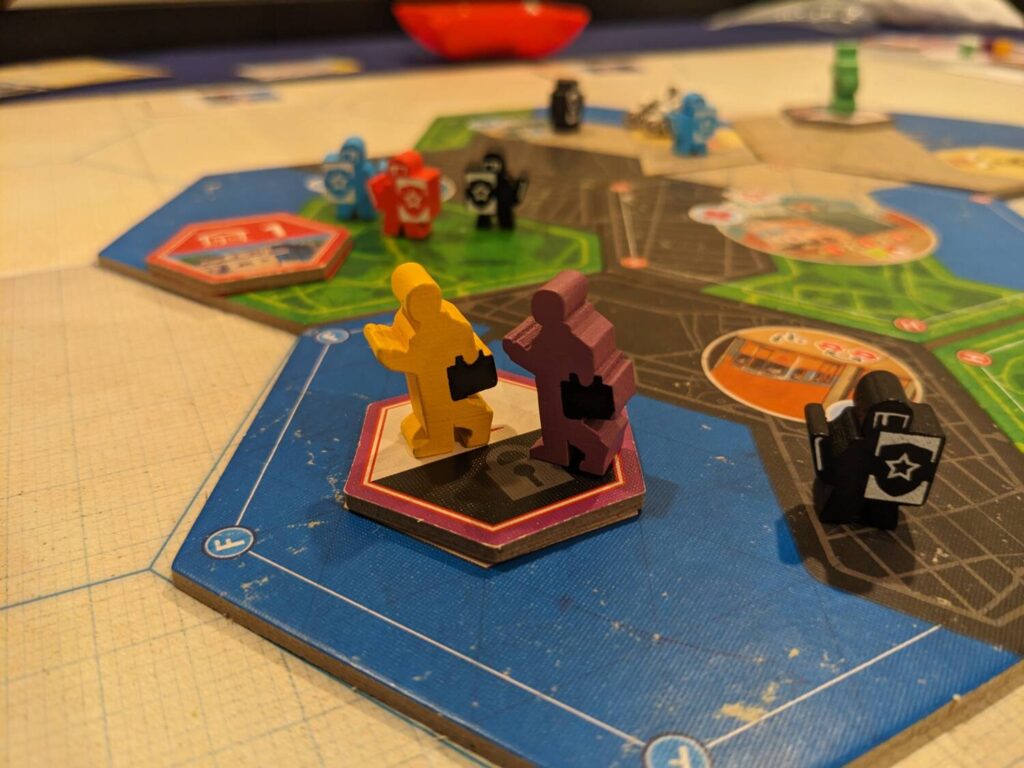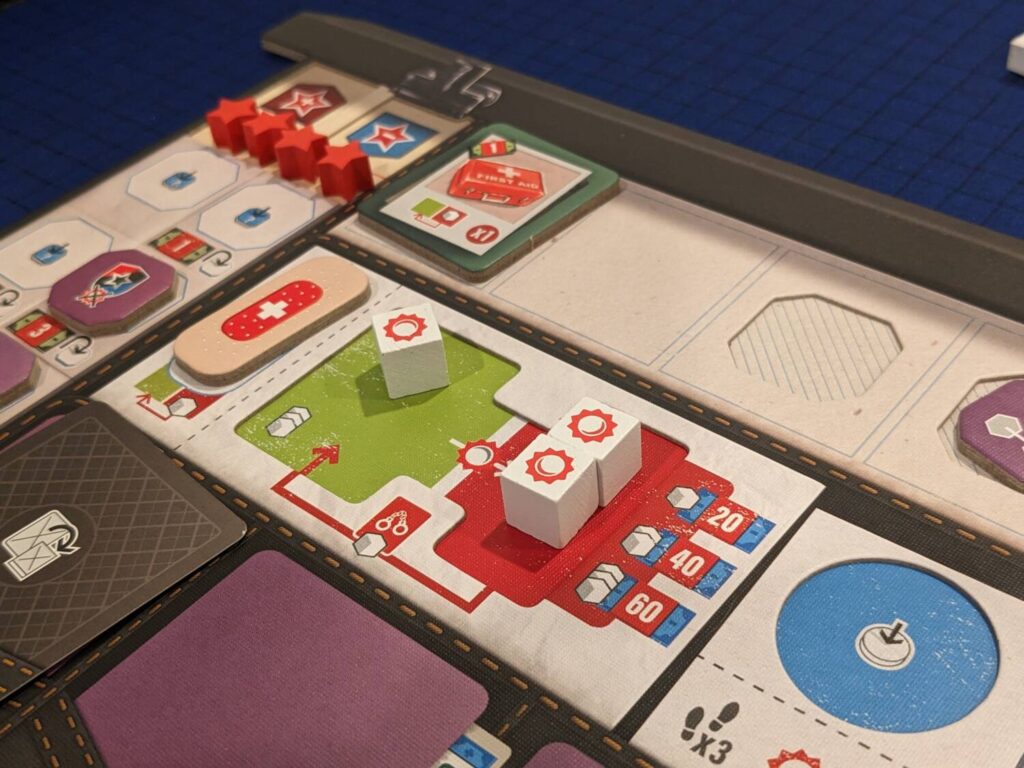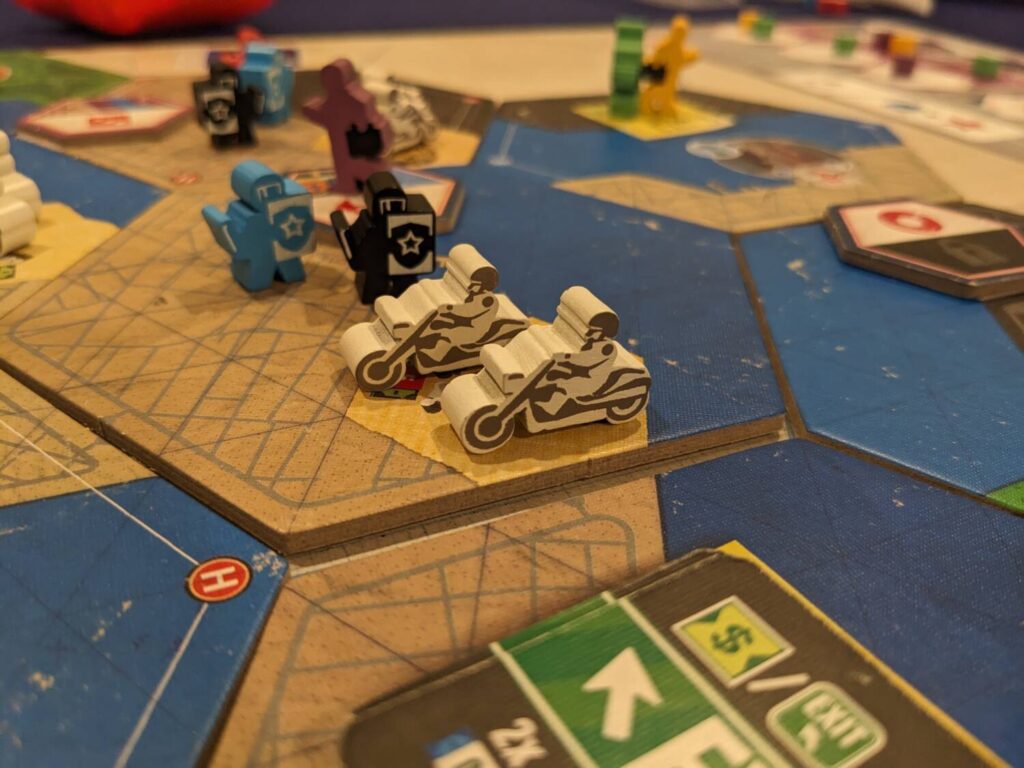One of the fun things about discussing the catalog of strategy game designer Vital Lacerda is finding out how each fan ranks Lacerda’s games. I have a lot of friends who enjoy Lacerda’s designs, and I am no exception…for a good part of 2021 and 2022, I tried to host a series of Lacerda-only game nights in Chicago called “Café Lacerda.”
Summer is a slower season for new tabletop releases as everyone gears up to make a splash at the big fall conventions (Gen Con, SPIEL, PAX Unplugged), so I have been going through my personal collection to find games that we haven’t previously reviewed here at Meeple Mountain. I got Escape Plan (2019, Eagle-Gryphon Games) back to the table recently (after logging a half-dozen plays in years past) and thought now would be a good time to publish my thoughts on the game.
Escape Plan is, amongst my circles and what appears to be the tabletop community at large, the most divisive game Lacerda has designed over the last 10 years. Everyone has an opinion. A limited few think of it as only OK, but almost everyone I spoke to in the lead-up to this post had something to say about what they thought about it.

A summary of recent texts included the following:
“Escape Plan? Too short.”
“Fantastic, and maybe my favorite of his games.”
“A mixed reaction at the table, so I put it up in a recent math trade.”
“I am holding onto my copy, but when we did our first play, I really didn’t like it.”
“I’ve only played Escape Plan solo. With these rules, I can’t teach it to my non-gamer friends, and my gamer friends think there’s not enough strategy elements involved, so I’ve never played it multiplayer.”
“I HATE the player elimination.” (This player was, obviously, eliminated from his game of Escape Plan, and swears he will never play it again.)
Looking back at the early plays, and coming back to it with two players new to Escape Plan recently, I am surprised to land here: Escape Plan is pretty good. Finding people who think it is Lacerda’s best game has proved difficult, but now that the smoke has cleared five years after it hit the market, I am seeing a growing number of people who recognize some of the greatest parts of the design.

Yep, It Might Only Last Seven Turns
Escape Plan is a 1-5 player strategy game that goes almost out its way to ensure it cannot be categorized. There is no worker placement. There is no action selection. There’s no area control. BGG tried its best and came up with “Enclosure”, “Hexagon Grid”, and “Area Movement”, none of which quite nail it. Players take on the role of former members of a gang who have a falling out…and the game is meant to serve as a chance for each to escape Unnamed City separately with the most money to win the game.
Escape Plan takes place over three days, each day broken into a minimum of three turns and a maximum of five. However, on the third day, players reveal the map tile that will serve as the exit for that playthrough, and can leave the board as soon as they want, even before their third turn. That means that in some games, players low on cash and the means needed to escape will leave the board on their seventh turn of the game.
That makes everything in Escape Plan exceptionally tight. You need money to take lots of actions, such as hiring biker gangs to avoid the cop meeples present on almost every tile. You’ll need to gather as much of the cash you have stashed across various businesses in the game, while also stopping at safe houses from time to time to hire one-time “Fixers” who can aid your escape. Those safe houses also have keys that can be used to visit lockers that have bags of cash that will add to your end-game score.
And while in-game money is tight, navigating the map is even tighter. Every turn, each criminal has to move from a location to an open space between locations. During these moments, Escape Plan tries its best to become an action film, as players have to avoid all the cop meeples (broken up into three different colors to require players to use different techniques to avoid everything in play) on every tile left behind on their way to the next destination. Escape Plan penalizes each player with wound tokens taken as they get shot by the cops when criminals are out in the open.
Escape Plan is the lightest of Lacerda’s heavy strategy game designs, but the main rules stumbling block comes when teaching the move mechanic to new players. Even during my most recent play, I needed to read the rules to make sure I had that part down, and counting out how the “Movement Points” (MPs) work is still a little too fancy for my tastes. But the move system works smoothly once you understand how it plays, and it always leads to some creative footwork to make sure players have enough MPs to get from place to place.

Money—it’s tight, remember? It’s so tight that you’ll find yourself running around the city to grab income (instant cash) a couple times early on, to build up the capital you’ll need to take actions near the end of the game. I love the money mechanics here. An income track slowly gets worse all game long, as players go to businesses to retrieve cash that will be scored at the end of the game. Each three-business set of the game’s nine locations has $150,000 to grab, but each player’s individual private goal card (the Escape Plan card) lists a different amount of money that a player is trying to grab at each business or safe house.
Also, each set of three businesses features two buildings that total the $150K, and one building that provides instant income. Visiting all three in a set earns an additional bonus, including the choice of taking an extra action in a day, which becomes very powerful late in the game.
The private goal variability of the escape plans is enough to make the modular map—built up by the players themselves between each day—a fun puzzle to navigate during each and every play. Then it becomes a race: who can grab the most money and get out of town before running out of cash on hand?
This is where Escape Plan becomes a potential hard pass for Eurogame fans: if you can’t get out of the city, you are arrested by the cops and eliminated from final scoring considerations. I’ve seen it happen in two of my plays, and it wasn’t a comfortable moment in either case. Personally, I love the way the rules play out for the ending. On the third day, any player can leave town as soon as they can reach the final exit, determined randomly by “Patrol” cards used during setup and only revealed at the beginning of the final round.
When a player skips town, they have to avoid any cops on the final exit tile, but pay no extra cash to leave the board. Then, any other players still on the map have to pay $1,000 just to take their turn, then anywhere from $5-$10K to exit the board. That means the final player to get out of town might have to pay at least $13K ($3K for three turns if they need that many, plus $10K) just to play the final round!!
This is where turn order becomes huge, and that’s where the Notoriety track comes in. Each round, players take actions that might raise their suspicion level with the cops. This comes in so many forms—Notoriety goes up when visiting a location where other players have a meeple. It goes up when drafting then playing Contact cards, which give the owner a special bonus for doing executive (bonus) actions. It goes up when you replace cards, money bags, or Fixer tiles on your player board. It goes up when you go to the hospital to heal, because in one of the more thematically-accurate moments of Escape Plan, hospitals are required to report victims of gunshot wounds.
(Yes, sometimes it goes down, such as when you use biker gangs to lower your Notoriety, or when you visit a safe house. Still, Notoriety is usually going up.)
At the start of each day, the player with the highest Notoriety gets to go first and place tiles in the modular map first. So, going first in the final round is huge, but ending the game with a high Notoriety negatively impacts scores.

For a Tactical Player, A Solid Entry
Amongst Lacerda designs, I think the final round of Escape Plan is the most tension-filled final round of them all, including the games he designed after Escape Plan.
That’s really saying something, given how good I think the final rounds can be in Kanban EV and Inventions: Evolution of Ideas. But so many things affect the ending here, and that starts with the fact that you don’t know the complete map layout until the final round. You also don’t really know where everyone is going to want to go with their final turn, because in-game cash—which was tight for most of the game—is hidden information. So you don’t know how much money your neighbor Stu has and he’s not going to tell you when he is thinking about skipping town until he absolutely has to!
I really enjoy the puzzle of how to best navigate the board while getting to the highest-value portions of my personal escape plan. In my most recent play, I wanted to get my high value businesses out first, but other players put businesses on the table that happened to be my income spaces. So I pivoted and picked up income three times in my first four turns to ensure I had a lot of cash, which saved me in the third round when I needed to take a full five actions to get everything I needed before escaping.
The Contact cards really elevate Escape Plan because of the way they change how players can best adjust their plans. Contact cards also add to end-game scoring by hoarding cards and they help open up options for convenience store lockers. Almost everything in the game integrates itself so nicely—the way Fixer tiles boost play with one-time actions, the ways that Notoriety forces players to move cops in your direction (or when you get to move cops in the direction of your opponents!) while also providing the bonus of other one-time actions (Asset tiles) that can be activated by spending cash on hand.
The two guys who joined me for my most recent play commented on what I have long believed—Lacerda REALLY loves meeples. The wooden toys on display here are so juicy. I love the criminal meeples, in a running motion holding a briefcase. I love the biker gang meeples. The cops look great. Did we really need gas can tokens? Of course we did. I still wish there were helicopter meeples that could move players from the heliport locations, but maybe that was overkill.

The player aids here aren’t the best, but they mostly do the job of conveying what is possible in each location. The rulebook is good, and rich with examples, but the layout is weak. Sometimes it is hard to find the edge case rules in the places you think they should reside. The storage solution is good, too. The best thing about the entire production is still the wrinkle I laugh at each time I remember that I haven’t done anything wrong: the main board and even the score pad is intentionally stained like a cop left their coffee mug on them. I always think my copy of the game got dirty somehow. Nope!
At three or four players, Escape Plan is great, and it plays very fast if everyone knows the rules. You can knock out a two-player game in under an hour, and 3-4 players can be done in under two hours, even well under two hours with the right people at the table.
Escape Plan works for me at all player counts except the solo. I did solo once, years ago, and swore I would never come back. Like other early Lacerda solo designs, I just don’t think Escape Plan‘s Sandra mechanic here works and doesn’t feature enough interaction with the game elements.
Escape Plan isn’t perfect. As mentioned, the movement rules are messy, and in a game where you have to move every turn (assuming you don’t take the pass action), that’s a factor. There are rules regarding the closure of businesses after a certain number of other players visit, based on player count. In a five-player game, it can be tricky early on if the last player in player order tries to go to a place that is closed because you need a key to open it up. I’m not sure I can make up a thematic reason for why my criminal—who is already, you know, a criminal—wouldn’t just break into said business to grab their bag of cash.
I’ll happily play Escape Plan any time I can. For those of you who have memories of the game not being positive, I encourage you to get it back to the table. It’s better than you remember!










